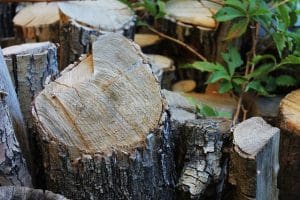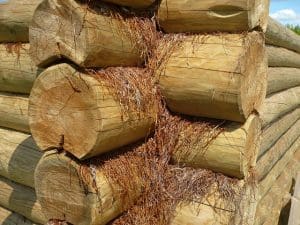Spring is an important time of year to take on some general log home maintenance. Inspecting your log home for winter damage from sitting snow, freezing water and chimney use, while preparing your home for warmer summer days ahead.
What does log home maintenance entail?
Log home maintenance involves the overall upkeep of its shell to protect it from water or UV damage, insect or rodent intrusion and damage caused by air infiltration; and contrary to popular belief, it is neither complex or expensive relative to the outcome in the end. The effort of spending two days a year, is well worth it when it means you’ll be avoiding more costly repairs in the long run while adding value to your log home.
Before you begin your annual log home spring maintenance there are a few tools you may need:
- A rough sketch of your log home’s walls, including the directions of North, East, South and West.
- Painter’s tape to mark any notable areas that require maintenance.
- A camera to take pictures of possible problem areas.
Once you have your tools in place, plan for your “Spring walk-around”. A second walk-around in the Fall would be advisable too to see how the seasons affect your log home and the preparations needed for the months to follow.
You’ll want to give yourself plenty of time to inspect every area of your log home, so give yourself at least a day to do this uninterrupted. There is no point in rushing the process as it’s only going to affect you in the long run. Make sure to pay particular attention to the South and West sides of your log home as they receive the most amount of sunlight exposure. Get to know your home’s behaviour and take into account these 6 key areas:
6 Key Log Home Maintenance Areas
Cleaning Gutters
Depending on your location and the type of winter experienced, a great deal of debris can accumulate on your roof over a short time span. Clogged gutters can create quite a problem for your log home, resulting in rot or a gutter that won’t even work properly. Spring is the best time to inspect for such conditions and remove any debris that has fallen from the fall and winter to ensure that your gutters remain clean, clear and functional. If your shingles are in need of repair or replacement then you can schedule a fix now before roofing contractors become busy. Flushing out your gutters once all debris has been removed is highly recommended to make sure that they will not back up and cause water damage.
Landscaping and Pruning
As beautiful as they can be, trees, shrubs and other plants placed too close to your log home can become a nightmare for your home. Make sure bushes and flowers are planted well away from your home’s exterior walls and that trees and shrubs are trimmed on a regular basis. This will ensure that moisture levels remain low and don’t splash up against the home.
Stacking, Piling and Burning Wood
Wood burning fires and log homes go hand-in-hand, but, it’s important to keep wood piles far from other log structures to allow for proper air circulation. Wood stacked right up against your home is not only a prime environment for moisture buildup that leads to mould and rot, but it is also an invitation for insects and rodents to make their way from your woodpile to your home’s structural wood.
Cleaning and Washing
Wash your log home at least twice a year to remove pollen, dirt and other airborne elements that may have settled on its surface. To clean your home, try Log Wash, liquid concentrate for cleaning log and wood surfaces that can be used as a maintenance cleaner or to prepare the surface of wood for a new coat of stain or topcoat.
Sealing Cracks and Gaps
During the winter months, cracks and gaps can occur as your log home shrinks and expands over time. This can cause your home’s energy efficiency to decrease, while also allowing water to get in behind the check. For these reasons, it’s important to address any and all cracks and gaps as soon as you find them. If you see any larger cracks, however, that seems to go through then more than half of a log, this is a reason to call a professional in as soon as possible.
For more details on log cracks and gaps check out this article here: Log Structures and Cracked Logs
Foundation
This is also a good time to check for any cracks in the foundation. Sometimes cracks can form during the extreme temperatures of the winter. Concrete and wood can seize up, shrink and then expand once the weather starts to warm up. If you have had a lot of precipitation, or if you’re experiencing drought conditions, you should also check the ground fill level. If it’s not adequately supporting your foundation, you could run into serious problems.
Refinishing Your Log Home
Your log home’s stain does not just serve an aesthetic purpose, but it protects your home’s wood from the elements as well. During your walk-around, if you notice that the staining is peeling or cracked in any area at all, it’s important that you contact a professional for a consultation, as your home may require a complete re-staining.
Check out our 4 steps to refinishing your log home.
Check Your Ventilation Systems
Help keep your home a clean and healthy living environment by maintaining your ventilation system. Whether you have a simple exhaust fan or heat, ventilation and air conditioning (HVAC) system you want to ensure that leaves or dirt haven’t collected on the fan blades or grill. This will block the air flow necessary for efficient operation and cost you energy dollars.
Look for Pests
With the weather warming up now is a good time to look for signs of insect or rodent activity by identifying any piles of sawdust or tunnelling. Powder Post Beetles, termites and carpenter ants are all frustrating insects that can yield unpleasant results if left unchecked and untreated. A well-maintained finish on your log home will help to minimize moisture accumulation, thus deterring these pesky insects.
Although maintaining your log home can be relatively straightforward, we understand you may not always have the time to commit to a thorough inspection so feel free to contact a local home maintenance company to help. If you do contact a local company make sure they have experience specifically with log homes as the maintenance for them can be slightly different.
Now comes the last and final step — to sit back and enjoy your well-maintained log home. Taking care of the maintenance now means you’ll be ready to enjoy the sunny days when the hot weather comes.
Are you wanting more information on log home maintenance and the importance it plays in the longevity of your home? Send us an email at info@artisanlog.com and we would be able to answer any questions you have.
For more log home maintenance tips check out these articles:




